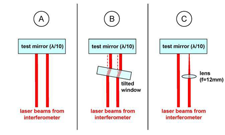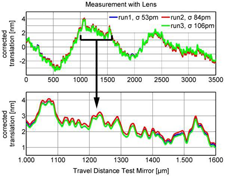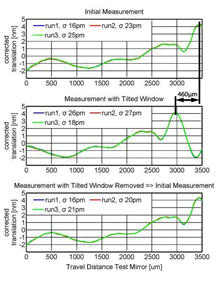picometer-characterization of high reflectivity laser mirrors
A measurement setup for the characterization of high reflectivity laser mirrors was developed todemonstrate the possibility of a 'piston' correction in optical paths due to scanning actuated laserbeams over surfaces of optical components. After the first successful measurements a test wasperformed to exclude the influence of parasitic pendulum movements in the measurement results.This test worked well and demonstrated that they are really surface induced. As the achieved resultsshow a limited lateral resolution, caused by the large laser beam diameters of the measurementsetup, an additional lens was integrated, which reduced the diameter of the measurement beam by afactor of about100.
Introduction
The IFPM (In-Field Pointing Mechanism) is used in an alternative payload concept for the LISA space mission to compensate for angular changes between the three interferometer arms due to constellation breathing of the individual spacecraft. Therefore IFPM steers the line of sight of the telescopes on the spacecraft with an actuated mirror in one of the telescope's intermediate pupil planes. Caused by the actuation, the laser beam of the interferometer, which is either sent or detected by the telescope, scans over the surface of the subsequent optical components in its path, resulting in path length errors called 'piston' which could potentially affect the required picometer sensitivity of the LISA measurement instrument.
Measurement



After the first successful 'piston' measurements of an l/10 test mirror further measurements were performed using longer measurement distances. The results are shown in Figure1. The curves are highly reproducible with a standard deviation of 16 pm (best value). They show amplitudes of several nanometers, which is considerably larger than the required LISA picometer scale.
In order to ensure that these results are not influenced by parasitic pendulum movements or other systematic effects, a simple test was performed using a tilted window in both laser beams. This window generates a lateral offset of the two laser beams on the mirror surface, see Figure 2, which should also be seen in the measurement results. Using Snell's law their offset is theoretically calculated to about 450μm.


 "
"